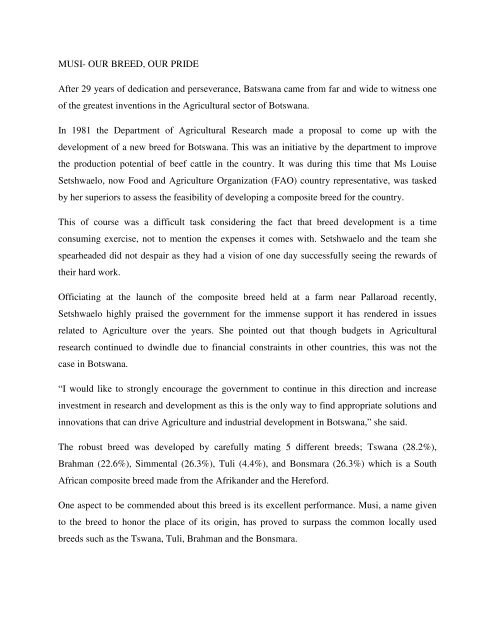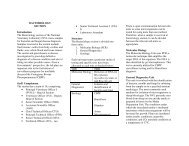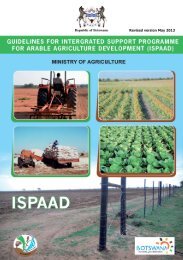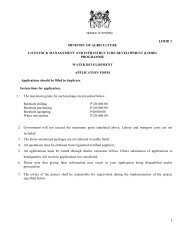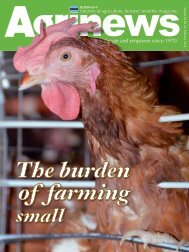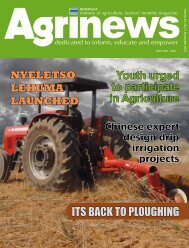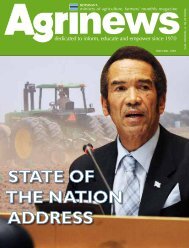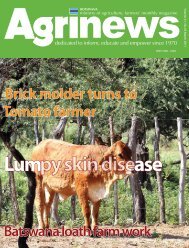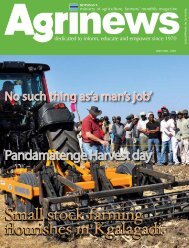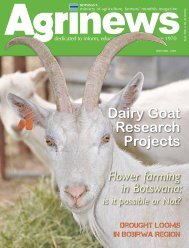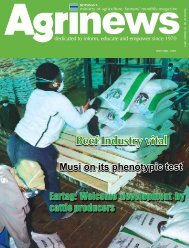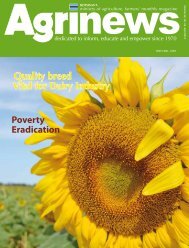composite breed
composite breed
composite breed
Create successful ePaper yourself
Turn your PDF publications into a flip-book with our unique Google optimized e-Paper software.
MUSI- OUR BREED, OUR PRIDEAfter 29 years of dedication and perseverance, Batswana came from far and wide to witness oneof the greatest inventions in the Agricultural sector of Botswana.In 1981 the Department of Agricultural Research made a proposal to come up with thedevelopment of a new <strong>breed</strong> for Botswana. This was an initiative by the department to improvethe production potential of beef cattle in the country. It was during this time that Ms LouiseSetshwaelo, now Food and Agriculture Organization (FAO) country representative, was taskedby her superiors to assess the feasibility of developing a <strong>composite</strong> <strong>breed</strong> for the country.This of course was a difficult task considering the fact that <strong>breed</strong> development is a timeconsuming exercise, not to mention the expenses it comes with. Setshwaelo and the team shespearheaded did not despair as they had a vision of one day successfully seeing the rewards oftheir hard work.Officiating at the launch of the <strong>composite</strong> <strong>breed</strong> held at a farm near Pallaroad recently,Setshwaelo highly praised the government for the immense support it has rendered in issuesrelated to Agriculture over the years. She pointed out that though budgets in Agriculturalresearch continued to dwindle due to financial constraints in other countries, this was not thecase in Botswana.“I would like to strongly encourage the government to continue in this direction and increaseinvestment in research and development as this is the only way to find appropriate solutions andinnovations that can drive Agriculture and industrial development in Botswana,” she said.The robust <strong>breed</strong> was developed by carefully mating 5 different <strong>breed</strong>s; Tswana (28.2%),Brahman (22.6%), Simmental (26.3%), Tuli (4.4%), and Bonsmara (26.3%) which is a SouthAfrican <strong>composite</strong> <strong>breed</strong> made from the Afrikander and the Hereford.One aspect to be commended about this <strong>breed</strong> is its excellent performance. Musi, a name givento the <strong>breed</strong> to honor the place of its origin, has proved to surpass the common locally used<strong>breed</strong>s such as the Tswana, Tuli, Brahman and the Bonsmara.
Assistant Minister of Agriculture, Mr Oreeditse Molebatsi, expressed his delight to witness thelaunch of the new <strong>breed</strong> which came as a result of many years of hard work.“Creation of our own <strong>composite</strong> <strong>breed</strong> is a remarkable achievement indeed, it is a pleasure toacknowledge that it is our <strong>breed</strong> and our pride,” he said.The <strong>composite</strong> <strong>breed</strong> bulls will be kept at Ramatlabama bull stud for semen collection tofacilitate farmers who wish to practice artificial insemination. The Department of AgriculturalResearch and Banyana farms will also work closely to multiply the <strong>breed</strong>. It is therefore withgreat anticipation that the <strong>breed</strong> will spread to the rest of Botswana as well as strengthen therelationship the country already has with other countries.


